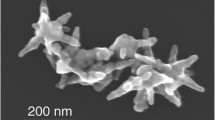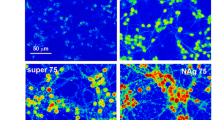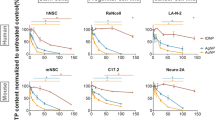Abstract
Gold nanoparticles (GNPs) have been extensively used in nanomedicine and neuroscience owing to their biological inertness, peculiar opto-electronic and physico-chemical features. However, the effect of GNPs shape on the neurophysiological properties of single neuron is still unclear. To tackle this issue, different shape GNPs (nanosphere, nanotriakisoctahedron and nanoflower) were synthesized to investigate the effect of GNPs on the voltage-dependent sodium channel and the action potential (AP) of hippocampal CA1 neurons in mice. The results indicated that GNPs inhibited the amplitudes of voltage-gated sodium current (INa) and led to a hyperpolarizing shift in the voltage-dependence curve of both activation and inactivation of INa. GNPs also increased neuronal excitability and altered some properties of AP. Moreover, most alterations in AP properties were observed in nanoflower GNPs treated CA1 neurons, suggesting that the neurotoxicity of gold nanoparticles is surface roughness-dependent. These results may provide a valuable direction in the clinical application of GNPs.
摘要
金纳米颗粒(GNPs), 由于其具有良好的生物稳定性、独特的光电和物理化学特性, 已被广泛用 于纳米医学和神经科学。但是, 不同形貌的GNPs对神经元的神经生理特性的影响仍不清楚。为解决 此问题, 合成了不同形状的GNPs(纳米球, 纳米六面体和纳米花)以研究不同表面粗糙度的GNPs对小 鼠海马CA1 神经元电压依赖性钠通道和动作电位(AP)的影响。结果表明, GNPs抑制了电压门控钠电 流(INa)的电流幅度, 使INa激活和失活的电压依赖性激活和失活曲线向超级化方向偏移。GNPs还增加了 神经元兴奋性并改变了动作电位的幅度、阈值、半波宽等参数变化。此外, 在纳米花GNPs处理过的 CA1 神经元中观察到了强度最大的AP改变(六面体次之, 球最小), 这表明金纳米颗粒的神经毒性与表 面粗糙度呈正相关。这些结果可能为GNPs的临床应用提供有价值的参考。
Similar content being viewed by others
References
CHO K, WANG Xu, NIE Shu-ming, CHEN Zhuo, SHIN D M. Therapeutic nanoparticles for drug delivery in cancer [J]. Clinical Cancer Research, 2008, 14(5): 1310–1316. DOI: https://doi.org/10.1158/1078-0432.CCR-07-1441.
TORCHILIN V P. Recent approaches to intracellular delivery of drugs and DNA and organelle targeting [J]. Annual Review of Biomedical Engineering, 2006, 8: 343–375. DOI: https://doi.org/10.1146/annurev.bioeng.8.061505.095735.
BOISSELIER E, ASTRUC D. Gold nanoparticles in nanomedicine: Preparations, imaging, diagnostics, therapies and toxicity [J]. Chemical Society Reviews, 2009, 38(6): 1759–1782. DOI: https://doi.org/10.1039/B806051G.
ETAME A B, DIAZ R J, O’REILLY M A, SMITH C A, MAINPRIZE T G, HYNYNEN K, RUTKA J T. Enhanced delivery of gold nanoparticles with therapeutic potential into the brain using MRI-guided focused ultrasound [J]. Nanomedicine-Nanotechnology Biology and Medicine, 2012, 8(7): 1133–1142. DOI: https://doi.org/10.1016/j.nano.2012.02.003.
KREYLING W G, SEMMLER M, ERBE F, MAYER P, TAKENAKA S, SCHULZ H, OBERDORSTER G, ZIESENIS A. Translocation of ultrafine insoluble iridium particles from lung epithelium to extrapulmonary organs is size dependent but very low [J]. Journal of Toxicology and Environmental Health Part A, 2002, 65(20): 1513–1530. DOI: https://doi.org/10.1080/00984100290071649.
OBERDORSTER G, SHARP Z, ATUDOREI V, ELDER A, GELEIN R, KRYLING W, COX C. Translocation of inhaled ultrafine particles to the brain [J]. Inhalation Toxicology, 2004, 16(6, 7): 437–445. DOI: https://doi.org/10.1080/08958370490439597.
HOET P H, BRUSKE-HOHLFELD I, SALATA O V. Nanoparticles-known and unknown health risks [J]. Journal of Nanobiotechnology, 2004, 2(1): 12. DOI: https://doi.org/10.1186/1477-3155-2-12.
ZHAO Jing-xia, XU Lan-ju, ZHANG Tao, REN Guo-gang, YANG Zhuo. Influences of nanoparticle zinc oxide on acutely isolated rat hippocampal CA3 pyramidal neurons [J]. Neurotoxicology, 2009, 30(2): 220–230. DOI: https://doi.org/10.1016/j.neuro.2008.12.005.
XU Lan-ju, ZHAO Jing-xia, ZHANG Tao, REN Guo-gang, YANG Zhuo. In vitro study on influence of nano particles of CuO on CA1 pyramidal neurons of rat hippocampus potassium currents [J]. Environmental Toxicology, 2009, 24(3): 211–217. DOI: https://doi.org/10.1002/tox.20418.
LIU Zhao-wei, ZHANG Tao, REN Guo-gang, YANG Zhuo. Nano-Ag inhibiting action potential independent glutamatergic synaptic transmission but increasing excitability in rat CA1 pyramidal neurons [J]. Nanotoxicology, 2012, 6(4): 414–423. DOI: https://doi.org/10.3109/17435390.2011.583996.
XIE Yong-jing, WANG Yi-yi, ZHANG Tao, REN Guo-gang, YANG Zhuo. Effects of nanoparticle zinc oxide on spatial cognition and synaptic plasticity in mice with depressive-like behaviors [J]. Journal of Biomedical Science, 2012, 19: 14. DOI: https://doi.org/10.1186/1423-0127-19-14.
LIU Zhao-wei, REN Guo-gang, ZHANG Tao, YANG Zhuo. Action potential changes associated with the inhibitory effects on voltage-gated sodium current of hippocampal CA1 neurons by silver nanoparticles [J]. Toxicology, 2009, 264(3): 179–184. DOI: https://doi.org/10.1016/j.tox.2009.08.005.
SHAN De-hong, XIE Yong-ling, REN Guo-gang, YANG Zhuo. Attenuated effect of tungsten carbide nanoparticles on voltage-gated sodium current of hippocampal CA1 pyramidal neurons [J]. Toxicology in Vtro, 2013, 27(1): 299–304. DOI: https://doi.org/10.1016/j.tiv.2012.08.025.
GUO Feng, YU Na, CAI Ji-qun, QUINN T, ZONG Zhihong, ZENG Yan-jun, HAO Li-ying. Voltage-gated sodium channel Nav1.1, Nav1.3 and beta1 subunit were up-regulated in the hippocampus of spontaneously epileptic rat [J]. Brain Research Bulletin, 2008, 75(1): 179–187. DOI: https://doi.org/10.1016/j.brainresbull.2007.10.005.
MEISLER M H, KEARNEY J A. Sodium channel mutations in epilepsy and other neurological disorders [J]. The Journal of Clinical Investigation, 2005, 115(8): 2010–2017. DOI: https://doi.org/10.1172/JCI25466.
JUNG S, BANG Min-ji, KIM B S, LEE S, KOTOV N A, KIM B, JEON D. Intracellular gold nanoparticles increase neuronal excitability and aggravate seizure activity in the mouse brain [J]. PloS One, 2014, 9(3): e91360. DOI: https://doi.org/10.1371/journal.pone.0091360.
SALINAS K, KERESELIDZE Z, DELUNA F, PERALTA X G, SANTAMARIA F. Transient extracellular application of gold nanostars increases hippocampal neuronal activity [J]. Journal of Nanobiotechnology, 2014, 12: 31. DOI: https://doi.org/10.1186/s12951-014-0031-y.
YI Man-fei, CHEN Liang-jian, HE Hui-li, SHI Lei, SHAO Chun-sheng, ZHANG Bo. Effects of grafting cell penetrate peptide and RGD on endocytosis and biological effects of Mg-CaPNPs-CKIP-1 siRNA carrier system in vitro [J]. Journal of Central South University, 2021, 28(5): 1291–1304. DOI: https://doi.org/10.1007/s11771-021-4697-7.
JIA Yan-peng, MA Bu-yun, WEI Xia-wei, QIAN Zhi-yong. The in vitro and in vivo toxicity of gold nanoparticles [J]. Chinese Chemical Letters, 2017, 28(4): 691–702. DOI: https://doi.org/10.1016/j.cclet.2017.01.021.
FENG Ning, SHEN Jing-jing, CHEN Yu, LI Chang, HU Yan-ling, ZHANG Lei, CHEN Shu-fen, FAN Qu-li, HUANG Wei, WANG Lian-hui. Multifunctional shape-dependent plasmonic nanoprobe by enzymatic etching of single gold triangular nanoplate [J]. Nano Research, 2020, 13(12): 3364–3370. DOI: https://doi.org/10.1007/s12274-020-3023-2.
CHEN Ye, FAN Zhan-xi, LUO Zhi-min, LIU Xiao-zhi, LAI Zhuang-chai, LI Bing, ZONG Yun, GU Lin, ZHANG Hua. High-yield synthesis of crystal-phase-heterostructured 4H/fccAu@Pd core-shell nanorods for electrocatalytic ethanol oxidation [J]. Advanced Materials, 2017, 29(36): 1701331. DOI: https://doi.org/10.1002/adma.201701331.
HUTTER E, BORIDY S, LABRECQUE S, LALANCETTE-HUBERT M, KRIZ J, WINNIK F M, MAYSINGER D. Microglial response to gold nanoparticles [J]. ACS Nano, 2010, 4(5): 2595–2606. DOI: https://doi.org/10.1021/nn901869f.
ZHANG Qin-qin, LARGE N, NORDLANDER P, WANG Hui. Porous Au nanoparticles with tunable plasmon resonances and intense field enhancements for single-particle SERS [J]. The Journal of Physical Chemistry Letters, 2014, 5: 370–374. DOI: https://doi.org/10.1021/jz402795x.
LIAO Rui, WANG Xing-xing, YANG Bao-jun, HONG Mao-xing, ZHAO Hong-bo, WANG Jun, QIU Guan-zhou. Catalytic effect of silver-bearing solid waste on chalcopyrite bioleaching: A kinetic study [J]. Journal of Central South University, 2020, 27(5): 1395–1403. DOI: https://doi.org/10.1007/s11771-020-4375-1.
TANG Mei-ling, XING Tai-ran, ZENG Jie, WANG Hui-li, LI Chen-chen, YIN Shu-ting, DENG Hong-min, LIU Jin, WANG Ming, CHEN Ju-tao, RUAN Di-yun. Unmodified CdSe quantum dots induce elevation of cytoplasmic calcium levels and impairment of functional properties of sodium channels in rat primary cultured hippocampal neurons [J]. Environmental Health Perspectives, 2008, 116(7): 915–922. DOI: https://doi.org/10.1289/ehp.11225.
CATTERALL W A, SCHMIDT J W, MESSNER D J, FELLER D J. Structure and biosynthesis of neuronal sodium channels [J]. Annals of the New York Academy of Sciences, 1986, 479: 186–203. DOI: https://doi.org/10.1111/j.1749-6632.1986.tb15570.x.
KRASZEWSKI S, YESYLEVSKYY SO, BOITEUX C, RAMSEYER C, KHARKYANEN V N. Is the mobility of the pore walls and water molecules in the selectivity filter of KcsA channel functionally important? [J]. Physical Chemistry Chemical Physics, 2008, 10(16): 2249–2255. DOI: https://doi.org/10.1039/B719512E.
BOITEUX C, KRASZEWSKI S, RAMSEYER C, GIRARDET C. Ion conductance vs. pore gating and selectivity in KcsA channel: Modeling achievements and perspectives [J]. Journal of Molecular Modeling, 2007, 13(6, 7): 699–713. DOI: https://doi.org/10.1007/s00894-007-0202-y.
CAHALAN M D. Modification of sodium channel gating in frog myelinated nerve fibres by Centruroides sculpturatus scorpion venom [J]. The Journal of Physiology, 1975, 244(2): 511–534. DOI: https://doi.org/10.1113/jphysiol.1975.sp010810.
JAIMOVICH E, ILDEFONSE M, BARHANIN J, ROUGIER O, LAZDUNSKI M. Centruroides toxin, a selective blocker of surface Na+ channels in skeletal muscle: Voltage-clamp analysis and biochemical characterization of the receptor [J]. Proceedings of the National Academy of Sciences of the United States of America, 1982, 79(12): 3896–3900. DOI: https://doi.org/10.1073/pnas.79.12.3896.
WANG G K, STRICHARTZ G R. Purification and physiological characterization of neurotoxins from venoms of the scorpions centruroides sculpturatus and leiurus quinquestriatus [J]. Molecular Pharmacology, 1983, 23(2): 519–533.
CESTELE S, QU Yu-sheng, ROGERS J C, ROCHAT H, SCHEUER T, CATTERALL W A. Voltage sensor-trapping: enhanced activation of sodium channels by beta-scorpion toxin bound to the S3–S4 loop in domain II [J]. Neuron, 1998, 21(4): 919–931. DOI: https://doi.org/10.1016/S0896-6273(00)80606-6.
BALSER J R. The cardiac sodium channel: Gating function and molecular pharmacology [J]. Journal of Molecular and Cellular Cardiology, 2001, 33(4): 599–613. DOI: https://doi.org/10.1006/jmcc.2000.1346.
KOOPMANN T T, BEZZINA C R, WILDE A A. Voltage-gated sodium channels: Action players with many faces [J]. Annals of Medicine, 2006, 38(7): 472–482. DOI: https://doi.org/10.1080/07853890600969072.
XIAO Ai-ying, WEI Ling, XIA Shui-li, ROTHMAN S, YU Shan-ping. Ionic mechanism of ouabain-induced concurrent apoptosis and necrosis in individual cultured cortical neurons [J]. The Journal of Neuroscience, 2002, 22(4): 1350–1362. DOI: https://doi.org/10.1523/JNEUROSCI.22-04-01350.2002.
JANVIER N C, BOYETT M R. The role of Na-Ca exchange current in the cardiac action potential [J]. Cardiovascular Research, 1996, 32(1): 69–84. DOI: https://doi.org/10.1016/S0008-6363(96)00017-X.
JANVIER N C, MCMORN S O, HARRISON S M, TAGGART P, BOYETT M R. The role of Na+-Ca2+ exchange current in electrical restitution in ferret ventricular cells [J]. The Journal of Physiology, 1997, 504(Pt2): 301–314. DOI: https://doi.org/10.1111/j.1469-7793.1997.301be.x.
XIE M, LYNCH D T, SCHOOLS G P, FEUSTEL P J, KIMELBERG H K, ZHOU M. Sodium channel currents in rat hippocampal NG2 glia: Characterization and contribution to resting membrane potential [J]. Neuroscience, 2007, 150(4): 853–862. DOI: https://doi.org/10.1016/j.neuroscience.2007.09.057.
HODGKIN A L, HUXLEY A F. A quantitative description of membrane current and its application to conduction and excitation in nerve [J]. The Journal of Physiology, 1952, 117(4): 500–544. DOI: https://doi.org/10.1113/jphysiol.1952.sp004764.
BERKEFELD H, FAKLER B, SCHULTE U. Ca2+-activated K+ channels: From protein complexes to function [J]. Physiological Reviews, 2010, 90(4): 1437–1459. DOI: https://doi.org/10.1152/physrev.00049.2009.
PARK K H, CHHOWALLA M, IQBAL Z, SESTI F. Singlewalled carbon nanotubes are a new class of ion channel blockers [J]. Journal of Biological Chemistry, 2003, 278(50): 50212–50216. DOI: https://doi.org/10.1074/jbc.M310216200.
CHIN C, KIM I K, LIM D Y, KIM K S, LEE H A, KIM E J. Gold nanoparticle-choline complexes can block nicotinic acetylcholine receptors [J]. International Journal of Nanomedicine, 2010, 5: 315–321. DOI: https://doi.org/10.2147/ijn.s10466.
Funding
Project(LY19C090004) supported by the Natural Science Foundation of Zhejiang Province, China; Projects(BK20200710, BK2018077) supported by the Natural Science Foundation of Jiangsu Province, China; Project(NHKY-2019-19) supported by the Nanjing Polytechnic Institute Start Fund, China; Project(202012920026Y) supported by the Innovation and Entrepreneurship Training Program of Jiangsu Province College Students, China
Author information
Authors and Affiliations
Corresponding authors
Rights and permissions
About this article
Cite this article
Lin, X., Hu, Yl., Zhang, C. et al. More severe toxicity of gold nanoparticles with rougher surface in mouse hippocampal neurons. J. Cent. South Univ. 28, 3642–3653 (2021). https://doi.org/10.1007/s11771-021-4844-1
Received:
Accepted:
Published:
Issue Date:
DOI: https://doi.org/10.1007/s11771-021-4844-1




